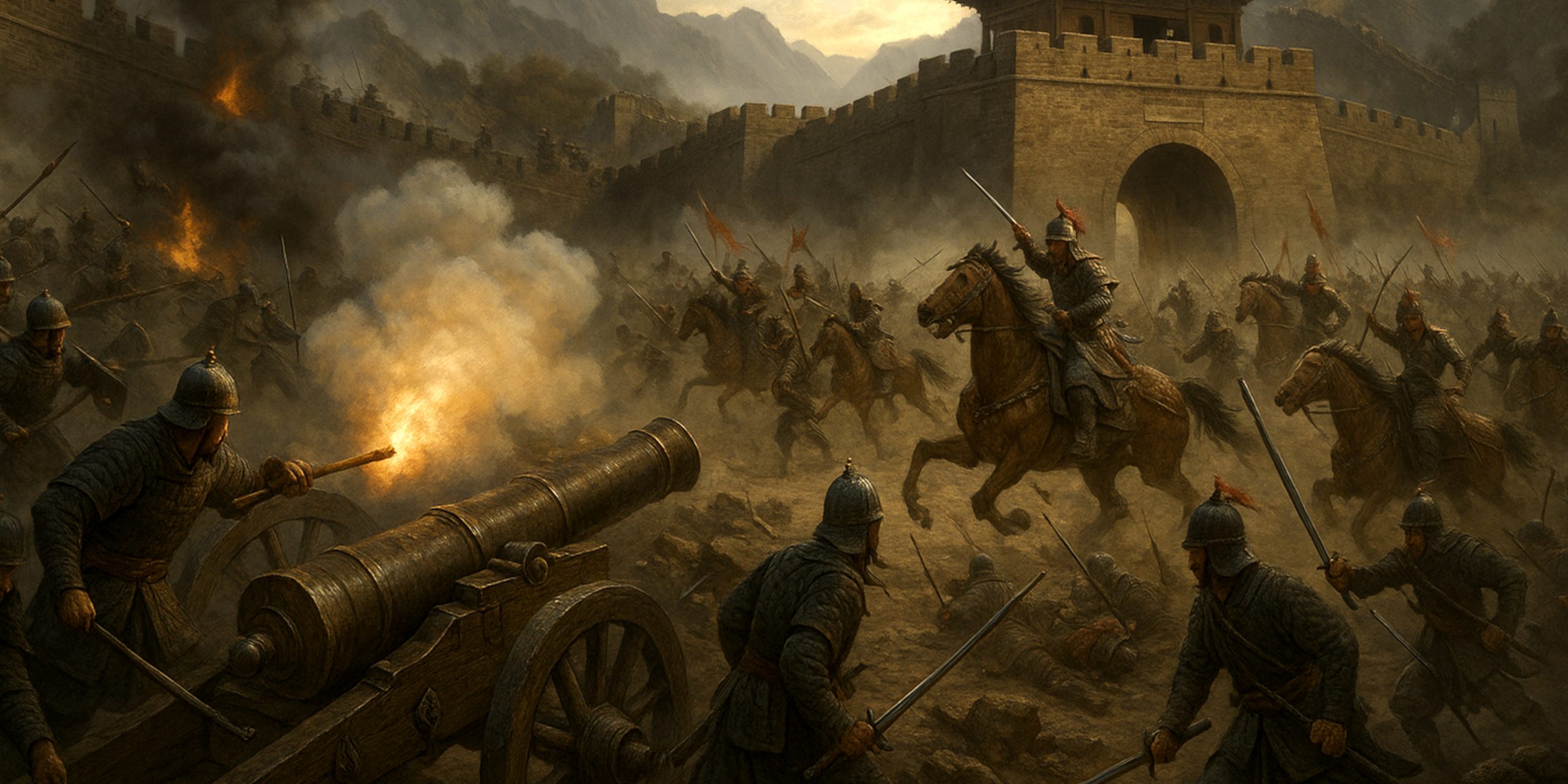
The Battle of Shanhai Pass, also known as (The Battle of Shanhaiguan) fought in 1644, was one of those rare turning points where a single gate decided the fate of a dynasty. Set against the monumental backdrop of the Great Wall of China, the conflict saw the crumbling Ming dynasty’s remnants join forces with the rising Manchu Qing to crush the rebel forces of Li Zicheng. What began as a desperate gamble by a Ming general ended with the foundation of a new imperial order that would rule China for nearly three centuries.
Background
By 1644, the Ming dynasty was in its death throes. Decades of corruption, famine, and rebellion had hollowed out the empire. The rebel leader Li Zicheng had already marched on Beijing, forcing the Chongzhen Emperor to hang himself on Coal Hill. Ming loyalist General Wu Sangui, stationed at Shanhai Pass on the easternmost end of the Great Wall, found himself between two advancing enemies: Li’s rebels from the west and the Manchu forces under Prince Dorgon from beyond the wall.
Wu’s choice was grim: surrender to Li, whom he despised, or ally with the Manchus, who were technically foreign invaders. In the end, he flung open the gates to the Manchu cavalry. It was an act that would seal both the Ming’s fate and his own complicated legacy.
Forces
| Side | Leader | Estimated Troops | Composition |
|---|---|---|---|
| Ming–Manchu Alliance | Wu Sangui and Prince Dorgon | c. 100,000 | Ming infantry, Manchu cavalry, artillery detachments |
| Shun Rebels (Li Zicheng’s forces) | Li Zicheng | c. 150,000 | Mixed infantry, cavalry, and poorly disciplined recruits |
Leaders and Troop Composition
Wu Sangui (Ming–Manchu side):
- A seasoned commander known for strict discipline and effective use of firearms and cavalry coordination.
- Controlled elite frontier troops familiar with the terrain of Shanhai Pass.
Prince Dorgon (Manchu):
- Regent and de facto leader of the Qing at the time.
- Commanded the elite Eight Banners cavalry, arguably the finest mobile force in East Asia.
Li Zicheng (Shun Dynasty):
- Charismatic rebel leader, but his army suffered from poor organisation and morale after taking Beijing.
- Relied heavily on sheer numbers rather than disciplined manoeuvres.
Arms and Armour
The clash at Shanhai Pass reflected the transitional nature of 17th-century Chinese warfare, blending traditional melee weapons with early gunpowder arms.
Ming–Manchu Alliance:
- Swords: Dao (single-edged sabres), Yanmaodao (goose-quill sabres), and Jian (straight double-edged swords for officers).
- Armour: Lamellar iron or steel plates bound with leather thongs; Manchu cavalry often used reinforced brigandines.
- Firearms: Ming matchlock muskets, Qing arquebuses, and early cannons positioned along the wall’s battlements.
- Bows: Manchu composite bows with bone and horn reinforcements, capable of piercing armour at close range.
Shun Rebels:
- Swords: Common dao and makeshift blades; many troops were peasants with agricultural tools.
- Armour: Limited, often just padded cloth or scavenged Ming armour.
- Firearms: Few, mostly captured Ming muskets, poorly maintained.
- Cavalry arms: Spears and sabres, used more for shock than precision.
The Battle
In May 1644, Li Zicheng’s forces advanced on Shanhai Pass, hoping to crush Wu Sangui before he could consolidate with the Manchus. The fighting opened with Ming artillery firing from the walls, followed by volleys of Manchu archery and cavalry counterattacks.
The decisive moment came when the Manchu cavalry, unleashed through the Great Wall’s gates by Wu, charged into Li’s disorganised lines. The rebels, already weary and poorly fed, collapsed under the combined onslaught. Li’s army broke, and he fled Beijing soon after, leaving it open to the Manchu advance. Within weeks, Prince Dorgon entered the city and proclaimed the beginning of the Qing dynasty.
Archaeology
The Shanhai Pass fortress still stands today as one of the best-preserved Great Wall strongholds, known as the “First Pass Under Heaven”. Excavations around the area have uncovered Ming-era cannonballs, fragments of lamellar armour, and ceramic matchlock barrels. A few bronze sabre fittings believed to belong to Wu Sangui’s troops are housed in the Shanhaiguan Great Wall Museum.
Archaeological surveys also reveal extensive restoration work from the Qing period, suggesting a deliberate effort to enshrine the site as a symbolic birthplace of the dynasty.
Battle Timeline
| Date | Event |
|---|---|
| April 1644 | Li Zicheng captures Beijing; Emperor Chongzhen dies by suicide. |
| May 1644 (early) | Wu Sangui refuses Li’s offer of alliance and fortifies Shanhai Pass. |
| May 1644 (mid) | Manchu forces under Dorgon approach the pass. Wu opens the gates and joins them. |
| 27 May 1644 | Main battle at Shanhai Pass. Combined Ming–Manchu forces rout Li Zicheng’s army. |
| June 1644 | Li retreats westwards; Dorgon marches on Beijing and establishes Qing control. |
Contemporary Quotes
A contemporary Ming record described the moment Wu Sangui opened the gate:
“The pass was as the throat of the empire. When it opened, the breath of the realm changed.”
A Manchu chronicler later wrote of Dorgon’s triumph:
“He entered not as conqueror, but as the saviour who restored order to a land undone by rebels.”
Wu Sangui’s own later reflection was notably bitter:
“I raised the tiger to chase away the wolf, and found it devoured my house.”
Legacy
The Battle of Shanhai Pass was both the end of the Ming and the beginning of the Qing. It remains one of the most debated events in Chinese history, with Wu Sangui’s decision viewed alternately as betrayal or tragic pragmatism. The Qing dynasty would rule until 1912, its rise sealed by the opening of a single gate in the Great Wall.
From a historian’s point of view, Shanhai Pass stands as a lesson in unintended consequences: when survival and loyalty collide, history rarely offers happy endings.
Watch the documentary:



